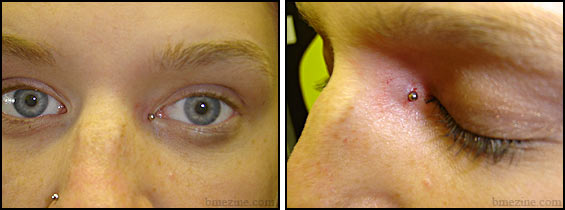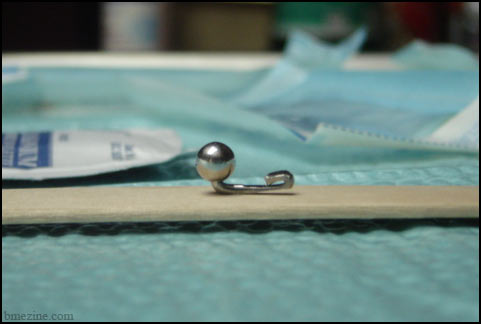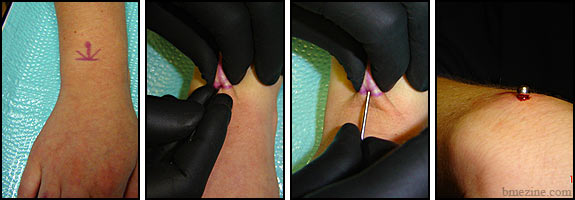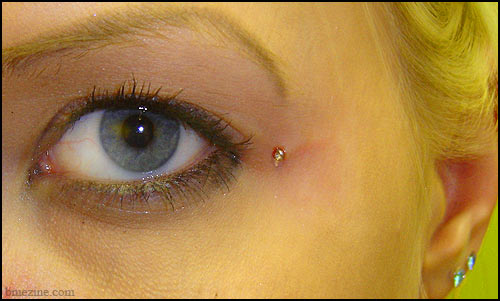 Dermal Anchoring
Dermal Anchoring
|
“Today every invention is received with a cry of triumph which soon turns into a cry of fear.”
– Bertolt Brecht
It’s not often these days that I get to document a new type of body modification procedure — most procedures are long since invented — so I was thrilled when Ben from House of Color in Colorado Springs sent me the following two photos titled, “eye boogie”.

The procedure, which he calls dermal anchoring, is something he came up with a few years ago and he feels he’s perfected over the last year. It’s starting to take off in Colorado Springs — Ben says he can’t make the custom jewelry fast enough to keep up with demand — and if it works as well as he says it does, perhaps that trend will spread even farther.
Among other things, you may remember Ben as the third person to hold the Guiness World Record for the most number of piercings on a single person in a single session (back in 2001 it was 227 piercings). Running from that notoriety he’s settled down at House of Color (“the first shop I really call home”).

Ben with a client
| BME: |
I assume you first considered the options of surface piercings and transdermal implants which cover similar territory? |
| BEN: |
Surface piercings and transdermal implants are very solid procedures — surface piercings are great, but if there’s too much tension on the skin or if they’re too heavy, they reject — you can counteract this by piercing deeper and through more tissue, but this means a longer healing time, increased infection risks, and a look that might not be right for the location. And transdermal implants need a lot of skill, and if done wrong can cause serious problems — just look at the words alone: the big one is “implant”. That means it’s permanent, and to remove it is a lengthy and very painful process.
|
| BME: |
Dermal anchoring seems similar to single-point pocketing?
|
| BEN: |
Yes, it is very close, although the dynamics and the design of the jewelry are what make it different. Really, I developed this procedure on a dare! My friend wanted the outside of her eye done. I didn’t want to risk the rejection from a surface piercing, and we only wanted one bead showing anyway. I offered her an implant, and she told me to fuck off, adding that I was smart enough to figure out another way — so I spent a few months hitting the books and making jewelry prototypes.
Cam was starting to become a pest about it, and eventually I was ready to try. The feeling of doing the procedure was overwhelming and made me sick to my stomach — I was so scared that if she moved, I’d hit her eye, and let’s face it — insurance won’t cover this.
|
| BME: |
Was the procedure successful?
|
| BEN: |
Yes, but unfortunately even after all that, the jewelry fell out in her sleep two days later. The jewelry was the problem — it wasn’t holding to the skin. I’ve been through six generations of jewelry design now — a few willing victims and a bit of trial and error development, and after the third or fourth time I started installing them in myself so no one else would get hurt — but I’ve finally got it right. I’m doing it in 18ga for anywhere around the eye, and 16ga to 12ga for other locations… I have five different kinds of jewelry in various designs up to high motion pieces that look like a scary fish hook… The geometry of the jewelry is the key to making it last.
|

Dermal anchor jewelry
| BME: |
How do you put the jewelry in? You said it’s simpler than a transdermal… |
| BEN: |
All it takes is a normal needle, the jewelery, and a steady hand. First you read the skin grain and watch the way it moves and bends. Let’s use the example of an outer eye — the grain is horizontal to the center of the eye. Lift the skin (eye closed) and insert the needle, without letting it come out the other side, going about a quarter of the way down on the needle stop. Then make a quick quarter turn and remove the needle, spinning it in reverse from your quarter turn. Next push the jewelry in place, and jiggle it lightly to move the flap into the crease in the jewelry. Finally, press down for about ten seconds.
|

Dermal anchor procedure
| BME: |
That’s really clever — how is the aftercare and healing? |
| BEN: |
Assuming the customer does what they’re told, they do great. For the first week they need to press on it six or seven times a day and cover it with a bandage at night, just until the anchor grabs the tissue better… Healing is really beautiful — minimal to no bruising, no blood after the jewelry is in… They just need to keep it clean with soap and saline solution every three hours. In dry climates like we have here in Colorado I’ve found it doesn’t dry out the tissues.
|
| BME: |
And the success rate?
|
| BEN: |
After I got the jewelry right, of the twenty or so I’ve done, the people who’ve taken care of them have had complete success. Those that haven’t taken care of it still tend to have the jewelry, but it shifts and moves out a little.
|

So close to the eye!
| BME: |
How do people react to dermal anchors when they see them? |
| BEN: |
“How is that in there?!” — they think it’s glued on… But most people really like them. A few piercers have tried to copy it but just managed to hurt and mess up their customers — of the shop whores in town got one done and then had to come to me two weeks later to remove it… and then asked me to do it right. I said no, which is good because I later found out her plan was to take it to another piercer so he could copy the jewelry…
Co-workers have pushed me to release it to the world, but I’m taking things slow. It’s still really new and I don’t promote it too much. If people ask, I tell them about it — normally the pictures in my portfolio get the conversation started. My philosophy as a piercer is that if you’re doing this for the money, you’re going about it wrong. This is an art form, and that is how it must be treated. That’s when your best work will come out.
|

Dermal anchor “ring”
| BME: |
Have you observed any risks that are unique to this procedure? |
| BEN: |
Not really… without any upward pressure on the skin, normal rejection doesn’t even happen. I guess if you go to a mosh pit, yeah, but you could also have your teeth “reject” there too. It’s just really important that people take care if it — you practically have to staple the aftercare instructions to their shirt for them to remember… But that’s all there is to it.
|
| BME: |
Any advice to piercers who’d like to try this?
|
| BEN: |
Please call me. I’ll tell you whatever you need to know, or if you live in Colorado or are making a stop, come in and say what’s up… Don’t try and do these with just your skill under your belt unless you’re really good. I’ve seen what happens when some guy says “I can do that”, and it doesn’t look pretty.
|

Multi-anchor star arrangement
Ben can be reached at House of Color in Colorado Springs at 719-390-4128, or you can drop him an email at [email protected]. By the time you read this, he may already have his first batch of jewelry from his manufacturer (all of the earlier pieces were custom made by him). If there’s an interest they’ll add the jewelry to their catalog, so you can talk to him about that as well.
Thank you to Ben for talking to us about this procedure, congratulations to him on being part of a that small roster of artists to contribute a new procedure, and I look forward to seeing more dermal anchoring in the future.

Shannon Larratt
BME.com









 BME/News and Modblog highlight only a small fraction of what
BME/News and Modblog highlight only a small fraction of what
would like to have you expound a bit on your style of piercing, also would like to purchase jewelry at later date, THANX,,,,,,,,,,,,,,,,Dianna ——Dee West DistLos Lunas New mexico 505 866-4644
would like to have you expound a bit on your style of piercing, also would like to purchase jewelry at later date, THANX,,,,,,,,,,,,,,,,Dianna ——Dee West DistLos Lunas New mexico 505 866-4644
I tried to email Ben, but it was returned to me, saying the domain was bad… so here’s my letter 🙂
Hey Ben
My name’s Faith, I’m the piercer at Addiction in New York City. I think your dermal anchoring technique is really rad, just read about it on BMEzine. I just had a couple questions that were a bit unclear to me. (Note,I’m not trying to copy, or even attempt this, I’m just really interested!)
How is this different from microdermals?
I’m also having some trouble visualizing your technique in my mind… with the way you say to “twist” the needles, I’m guessing it’s creating a flap of tissue inside the “pocket”?
I’m really into learning about cutting(no pun intended) edge techniques in the body mod world, and hope to one day create the next new thing 😀
Faith Alana Alastair
Addiction West
NYC, NY
I tried to email Ben, but it was returned to me, saying the domain was bad… so here’s my letter 🙂
Hey Ben
My name’s Faith, I’m the piercer at Addiction in New York City. I think your dermal anchoring technique is really rad, just read about it on BMEzine. I just had a couple questions that were a bit unclear to me. (Note,I’m not trying to copy, or even attempt this, I’m just really interested!)
How is this different from microdermals?
I’m also having some trouble visualizing your technique in my mind… with the way you say to “twist” the needles, I’m guessing it’s creating a flap of tissue inside the “pocket”?
I’m really into learning about cutting(no pun intended) edge techniques in the body mod world, and hope to one day create the next new thing 😀
Faith Alana Alastair
Addiction West
NYC, NY